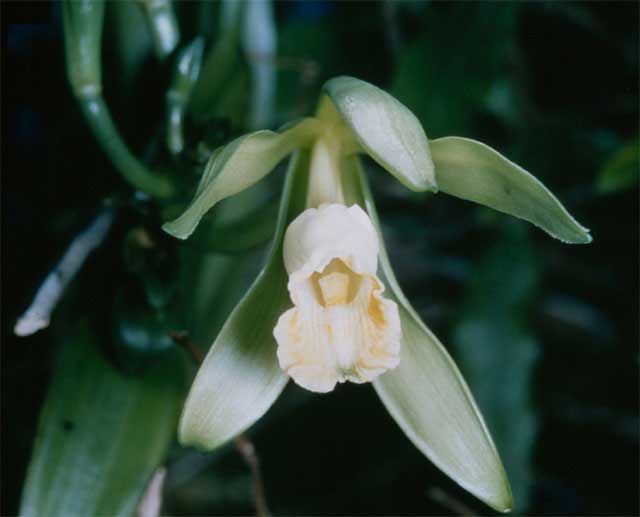
Vanilla planifolia , Photo: Everglades National Park
Classification System: APG IV
Superregnum: Eukaryota
Regnum: Plantae
Cladus: Angiosperms
Cladus: Monocots
Ordo: Asparagales
Familia: Orchidaceae
Subfamilia: Vanilloideae
Tribus: Vanilleae
Genus: Vanilla
Species: Vanilla planifolia
Name
Vanilla planifolia Jacks. ex Andrews, Bot. Repos. 8: t. 538 (1808)
Synonymy
Homotypic
Notylia planifolia (Jacks. ex Andrews) Conz., Fl. Taxon. Mexic. 3: 151 (1947)
Heterotypic
Epidendrum rubrum Lam., Encycl. 1: 178 (1783)
Vanilla aromatica Willd., Sp. Pl. 4: 121 (1805), nom. illeg.
Myrobroma fragrans Salisb., Parad. Lond.: t. 82 (1807), nom. illeg.
Vanilla viridiflora Blume, Bijdr.: 422 (1825)
Vanilla sativa Schiede, Linnaea 4: 573 (1829)
Vanilla sylvestris Schiede, Linnaea 4: 573 (1829)
Vanilla duckei Huber, Bol. Mus. Goeldi Hist. Nat. Ethnogr. 5: 327 (1909)
Vanilla rubra (Lam.) Urb., Repert. Spec. Nov. Regni Veg. Beih. 5: 157 (1920)
Vanilla fragrans Ames, Schedul. Orchid. 7: 36 (1924), nom. illeg.
Vanilla planifolia var. angusta Costantin & Boiss. ex C.Henry, Agric. Colon. 83: 135 (1924)
Notylia sativa (Schiede) Conz., Fl. Taxon. Mexic. 3: 151 (1947)
Notylia sylvestris (Schiede) Conz., Fl. Taxon. Mexic. 3: 151 (1947), nom. illeg.
Vanilla bampsiana Geerinck, Bull. Jard. Bot. Natl. Belg. 52: 345 (1982)
Distribution
Native distribution areas:
Northern America
Mexico
Mexico Gulf, Mexico Southwest, Mexico Southeast.
Southern America
Central America
Belize, Costa Rica, El Salvador, Guatemala, Honduras, Nicaragua.
Western South America
Colombia.
References: Brummitt, R.K. 2001. TDWG – World Geographical Scheme for Recording Plant Distributions, 2nd Edition
References
Primary references
Jackson, G. ex Andrews, H.C. 1808. Botanist's Repository, for new, and rare plants 8: t. 538.
Additional references
Soto Arenas, M.A. & Cribb, P. 2010. A new infrageneric classification and synopsis of the genus 'Vanilla' Plum. ex Mill. (Orchidaceae: Vanillinae). Lankesteriana 9: 355–398.
Links
Govaerts, R. et al. 2020. Vanilla planifolia in Kew Science Plants of the World online. The Board of Trustees of the Royal Botanic Gardens, Kew. Published on the internet. Accessed: 2020 April 9. Reference page.
Govaerts, R. et al. 2020. Vanilla planifolia in World Checklist of Selected Plant Families. The Board of Trustees of the Royal Botanic Gardens, Kew. Published on the internet. Accessed: 2020 April 9. Reference page.
International Plant Names Index. 2020. Vanilla planifolia. Published online. Accessed: 9 April 2020.
The Plant List 2013. Vanilla planifolia in The Plant List Version 1.1. Published on the internet. Accessed: 2020 April 9.
Tropicos.org 2020. Vanilla planifolia. Missouri Botanical Garden. Published on the internet. Accessed: 2020 April 9.
Vernacular names
English: Vanilla
Vanilla planifolia is a species of vanilla orchid. It is native to Mexico, Guatemala and Belize.[1] It is one of the primary sources for vanilla flavouring, due to its high vanillin content. Common names include flat-leaved vanilla,[3] and West Indian vanilla (also used for the Pompona vanilla, V. pompona). Often, it is simply referred to as "the vanilla". It was first scientifically named in 1808. With the species' population in decline and its habitats being converted to other purposes, the IUCN has assessed Vanilla planifolia as Endangered.[1]
Habitat
It prefers hot, wet, tropical climates.[4]
It is cultivated and harvested primarily in Veracruz, Mexico, Tahiti,, Indonesia, and Madagascar.[4]
Description
Like all members of the genus Vanilla, V. planifolia is a vine. It uses its fleshy roots to support itself as it grows.
Flowers
Vanilla planifolia, flower
Flowers are greenish-yellow, with a diameter of 5 cm (2 in). They last only a day, and must be pollinated manually, during the morning, if fruit is desired. The plants are self-fertile, and pollination simply requires a transfer of the pollen from the anther to the stigma. If pollination does not occur, the flower is dropped the next day. In the wild, there is less than 1% chance that the flowers will be pollinated, so in order to receive a steady flow of fruit, the flowers must be hand-pollinated when grown on farms.
Fruit
Fruit is produced only on mature plants, which are generally over 3 m (10 ft) long. The fruits are 15–23 cm (6–9 in) long pods (often incorrectly called beans). Outwardly they resemble small bananas. They mature after about five months, at which point they are harvested and cured. Curing ferments and dries the pods while minimizing the loss of essential oils. Vanilla extract is obtained from this portion of the plant.
Chemistry
The major chemical components from the pods are vanillin, vanillic acid, 4-hydroxybenzaldehyde and 4-hydroxybenzoic acid.[5]
Contact dermatitis
Illustration of allergic contact dermatitis
When propagating vanilla orchids from cuttings or harvesting ripe vanilla pods, care must be taken to avoid contact with the sap from the plant's stems. The sap of most species of Vanilla orchid which exudes from cut stems or where pods are harvested can cause moderate to severe dermatitis if it comes in contact with bare skin. Washing the affected area with warm soapy water will effectively remove the sap in cases of accidental contact with the skin. The sap of vanilla orchids contains calcium oxalate crystals, which appear to be the main causative agent of contact dermatitis in vanilla plantation workers.[6][7][8][9][10]
See also
Vanilla tahitensis
References
Vega, M.; Hernández, M.; Herrera-Cabrera, B.E.; Wegier, A. (2020). "Vanilla planifolia". IUCN Red List of Threatened Species. 2020: e.T103090930A172970359. doi:10.2305/IUCN.UK.2020-2.RLTS.T103090930A172970359.en. Retrieved 19 November 2021.
The Plant List: A Working List of All Plant Species, retrieved 26 January 2016
"Vanilla planifolia (Commercial Vanilla, Flat Leaved Vanilla): Go Orchids". goorchids.northamericanorchidcenter.org. Retrieved 2020-06-20.
GRIN-Global Web v 1.9.4.2: Taxonomy of Vanilla planifolia
Reinvestigation of vanillin contents and component ratios of vanilla extracts using high-performance liquid chromatography and gas chromatography. Scharrer A and Mosandl A, Deutsche Lebensmittel-Rundschau, 2001, volume 97, number 12, pages 449-456, INIST:14118840
"Vanilla Orchid Care - OrchidsMadeEasy.com".
"Cultural Requirements of the Vanilla Orchid" (PDF).
"Growing Vanilla Bean Plants (Vanilla planifolia orchid). Vanilla Plants and seeds for sale. - NurseriesOnline". 8 August 2015.
"Vanilla planifolia Andrews - Plants of the World Online - Kew Science". powo.science.kew.org.
"Vanilla planifolia Vanilla PFAF Plant Database". pfaf.org.
Retrieved from "http://en.wikipedia.org/"
All text is available under the terms of the GNU Free Documentation License


